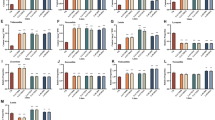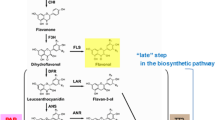Abstract
One of the drawbacks in inducing the synthesis of ketocarotenoids in transgenic plants is the accompanying decrease in β-carotene level, especially in transgenic plants overexpressing only a β-carotene ketolase. In an attempt to overcome this drawback, we isolated a β-carotene ketolase (HpBkt) cDNA from Haematococcus pluvialis and generated transgenic carrot plants overexpressing HpBkt cDNA under the control of the ibAGP1 promoter and its transit peptide sequence. Semi-quantitative reverse transcriptase-PCR with total RNAs extracted from taproot tissues of five lines of the generated HpBkt-transgenic carrot plants revealed variable levels of the inserted HpBkt transcript, ranging from very low to high. All of the HpBkt-transgenic carrot plants tested produced astaxanthin, resulting in a color change from the light-orange coloration of wild-type taproots to a dark-orange–reddish coloration in the taproots of the HpBkt-transgenic plants. The astaxanthin content was not correlated with the HpBkt transcript level. Overexpression of HpBkt caused an increase in the transcript levels of the endogenous carotenogenic genes, including phytoene synthase 1 (PSY1), phytoene synthase 2 (PSY2), lycopene β-cyclase 1 (LCYB1), and β-carotene hydroxylase 1 (CHXB1), which resulted in elevated β-carotene levels in the HpBkt-transgenic plants (range 1.3- to 2.5-fold) compared to the wild-type plants. These results demonstrate that HpBkt-overexpressing carrot plants under the control of the ibAGP1 promoter and its transit peptide are capable of both newly synthesizing ketocarotenoids and enhancing their β-carotene level.




Similar content being viewed by others
References
Bramley PM (2002) Regulation of carotenoid formation during tomato fruit ripening and development. J Exp Bot 53:2107–2113
Chew BP, Mathison BD, Hayek MG, Massimino S, Reinhart GA, Park JS (2011) Dietary astaxanthin enhances immune response in dogs. Vet Immunol Immunopathol 140:199–206
Clotault J, Peltier D, Berruyer R, Thomas M, Briard M, Geoffriau E (2008) Expression of carotenoid biosynthesis genes during carrot root development. J Exp Bot 59:3563–3573
Cunningham FX, Gantt E (1998) Genes and enzymes of carotenoids biosynthesis in plants. Annu Rev Plant Physiol Plant Mol Biol 49:557–583
Cunningham FX, Gantt E (2005) A study in scarlet: enzymes of ketocarotenoid biosynthesis in the flowers of Adonis aestivalis. Plant J 41:478–492
Curek GD, Cort A, Yucel G, Demir N, Ozturk S, Elpek GO, Savas B, Aslan M (2010) Effect of astaxanthin on hepatocellular injury following ischemia/reperfusion. Toxicology 267:147–153
Fraser PD, Bramley PM (2004) The biosynthesis and nutritional uses of carotenoids. Prog Lipid Res 43:228–265
Fujisawa M, Takita E, Harada H, Sakurai N, Suzuki H, Ohyama K, Shibata D, Misawa N (2009) Pathway engineering of Brassica napus seeds using multiple key enzyme genes involved in ketocarotenoid formation. J Exp Bot 60:1319–1332
Gerjets T, Sandmann G (2006) Ketocarotenoid formation in transgenic potato. J Exp Bot 57:3639–3645
Goodwin TW (1980) The biochemistry of the carotenoids, vol 1, 2nd edn. Chapman and Hall, London
Guruvayoorappan C, Kuttan G (2007) β-Carotene down-regulates inducible nitric oxide synthase gene expression and induces apoptosis by suppressing bcl-2 expression and activating caspase-3 and p53 genes in B16F-10 melanoma cells. Nutr Res 27:336–342
Ha SH, Liang YS, Jung H, Ahn MJ, Suh SC, Kweon SJ, Kim DH, Kim YM, Kim JK (2010) Application of two bicistronic systems involving 2A and IRES sequences to the biosynthesis of carotenoids in rice endosperm. Plant Biotechnol J 8:928–938
Hasunuma T, Miyazawa S, Yoshimura S, Shinzaki Y, Tomizawa K, Shindo K, Choi SK, Misawa N, Miyake C (2008) Biosynthesis of astaxanthin in tobacco leaves by transplastomic engineering. Plant J 55:857–868
Hirschberg J (2001) Carotenoid biosynthesis in flowering plants. Curr Opin Plant Biol 4:210–218
Huang J-C, Chen F, Sandmann G (2006) Stress-related differential expression of multiple β-carotene ketolase genes in the unicellular green alga Haematococcus pluvialis. J Biotechnol 122:176–185
Iwamoto T, Hosoda K, Hirano R, Kurata H, Matsumoto A, Miki W, Kamiyama M, Itakura H, Yamamoto S, Kondo K (2000) Inhibition of low-density lipoprotein oxidation by astaxanthin. J Atheroscler Thromb 7:216–222
Jayaraj J, Devlin R, Punja Z (2008) Metabolic engineering of novel ketocarotenoid production in carrot plants. Transgenic Res 17:489–501
Johnson H, An GH (1991) Astaxanthin from microbial sources. Crit Rev Biotechnol 11:297–326
Just BJ, Santos CA, Fonseca ME, Boiteux LS, Oloizia BB, Simon PW (2007) Carotenoid biosynthesis structural genes in carrot (Daucus carota): isolation, sequence-characterization, single nucleotide polymorphism (SNP) markers and genome mapping. Theor Appl Genet 114:693–704
Kwak MS, Oh MJ, Lee SW, Shin JS, Paek KH, Bae JM (2007) A strong constitutive gene expression system derived from ibAGP1 promoter and its transit peptide. Plant Cell Rep 26:1253–1262
Lotan T, Hirschberg J (1995) Cloning and expression in Escherichia coli of the gene encoding β-C-4 oxygenase, that converts β-carotene to the ketocarotenoid canthaxanthin in Haematococcus pluvialis. FEBS Lett 364:125–128
Lu Y-P, Liu S-Y, Sun H, Wu X-M, Li J–J, Zhu L (2010) Neuroprotective effect of astaxanthin on H2O2-induced neurotoxicity in vitro and on focal cerebral ischemia in vivo. Brain Res 1360:40–48
Mann V, Harker M, Pecker I, Hirschberg J (2000) Metabolic engineering of astaxanthin production in tobacco flowers. Nat Biotechnol 18:888–892
Miki W (1991) Biological functions and activities of animal carotenoids. Pure Appl Chem 63:141–146
Noh SA, Lee HS, Huh GH, Oh M-J, Paek K-H, Shin JS, Bae JM (2011) A sweetpotato SRD1 promoter confers strong root, taproot, and tuber-specific expression in Arabidopsis, carrot, and potato. Transgenic Res. doi:10.1007/s11248-011-9528-4
Preuss HG, Echard B, Bagchi D, Perricone NV, Yamashita E (2009) Astaxanthin lowers blood pressure and lessens the activity of the renin-angiotensin system in Zucker Fatty Rats. J Funct Foods 1:13–22
Ralley L, Enfissi EM, Misawa N, Schuch W, Bramley PM, Fraser PD (2004) Metabolic engineering of ketocarotenoid formation in higher plants. Plant J 39:477–486
Rao AV, Rao LG (2007) Carotenoids and human health. Pharmacol Res 55:207–216
Renstorm B, Berger H, Liaaen-Jensen S (1981) Esterified, optically pure (3S, 3′S)-astaxanthin from flowers of Adonis annua. Biochem Syst Ecol 9:249–250
Sandmann G (2001) Carotenoid biosynthesis and biotechnological application. Arch Biochem Biophys 385:4–12
Seybold A, Goodwin TW (1959) Occurrence of astaxanthin in the flower petals of Adonis annua L. Nature 184:1714–1715
Stålberg K, Lindgren O, Ek B, Höglund AS (2003) Synthesis of ketocarotenoids in the seed of Arabidopsis thaliana. Plant J 36:771–779
Visser H, van Ooyen AJJ, Verdoes JC (2003) Metabolic engineering of the astaxanthin-biosynthetic pathway of Xanthophyllomyces dendrohous. FEMS Yeast Res 4:221–231
Woodall AA, Britton G, Jackson MJ (1997) Carotenoids and protection of phospholipids in solution or in liposomes against oxidation by peroxyl radicals: relationship between carotenoid structure and protective ability. Biochim Biophys Acta 1336:575–586
Yu B, Lydiate DJ, Young LW, Schäfer UA, Hannoufa A (2008) Enhancing the carotenoid content of Brassica napus seeds by downregulating lycopene epsilon cyclase. Transgenic Res 17:573–585
Acknowledgments
This work was supported by Grants (No. PJ008076 and No. PJ008103 to JM Bae, No. PJ008119 to MJ Ahn, No. PJ008097 to SW Lee) from the Next-Generation BioGreen 21 Program Rural Development Administration, Republic of Korea, and a research fund of the National Institute of Agricultural Science (PJ0068342011) to SH Ha.
Author information
Authors and Affiliations
Corresponding author
Rights and permissions
About this article
Cite this article
Ahn, MJ., Noh, S.A., Ha, SH. et al. Production of ketocarotenoids in transgenic carrot plants with an enhanced level of β-carotene. Plant Biotechnol Rep 6, 133–140 (2012). https://doi.org/10.1007/s11816-011-0206-z
Received:
Accepted:
Published:
Issue Date:
DOI: https://doi.org/10.1007/s11816-011-0206-z




